The Board of Agriculture and Internal Improvement undertook an important survey of agriculture and rural improvement in Britain from 1793 to 1817. Each survey generally focused on a county or a small number of counties.
The accounts contained detailed accounts of the implements and machines used in each county, together with the changes that were being made to them.
The account for Inverness-shire written by James Robertson, provides insights into the character and state of implements used in that county.
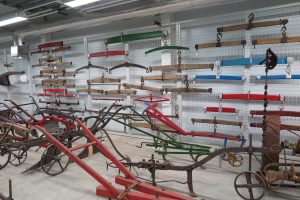 “The implements of husbandry which are used by the inhabitants of any country, no less than the construction of their houses and the appearance of their ground, are characteristic of the progress which they have made in the knowledge of agriculture, and in their enjoyment of the comforts of life. These improvements are either simultaneous, or so nearly allied in respect of the principle to which they owe their origin, and the time in which they appear in any country, that they are universally found to exist together. Wherever we see the farmers turning up the surface of the earth in a slovenly manner, and employing uncouth and unhandy tools for providing their own food, which is the first care of every living creature, we instantly conclude thatchy are far behind in the line of cultivation. but wherever any of these improvements have made considerable progress, the rest are not far behind.
“The implements of husbandry which are used by the inhabitants of any country, no less than the construction of their houses and the appearance of their ground, are characteristic of the progress which they have made in the knowledge of agriculture, and in their enjoyment of the comforts of life. These improvements are either simultaneous, or so nearly allied in respect of the principle to which they owe their origin, and the time in which they appear in any country, that they are universally found to exist together. Wherever we see the farmers turning up the surface of the earth in a slovenly manner, and employing uncouth and unhandy tools for providing their own food, which is the first care of every living creature, we instantly conclude thatchy are far behind in the line of cultivation. but wherever any of these improvements have made considerable progress, the rest are not far behind.
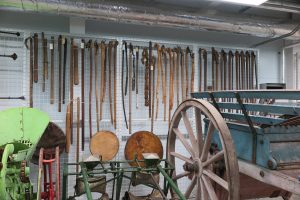 The general aspect of the county under review, is very much diversified; the genius and industry of the people, and the instruments of their husbandry, are no less so. In some provinces, all the modern improvements invented to facilitate the labours of agriculture, and to beautify the appearance of their lands, are to be seen in the highest perfection; while in other places, no change has taken place in these respects for many generations.
The general aspect of the county under review, is very much diversified; the genius and industry of the people, and the instruments of their husbandry, are no less so. In some provinces, all the modern improvements invented to facilitate the labours of agriculture, and to beautify the appearance of their lands, are to be seen in the highest perfection; while in other places, no change has taken place in these respects for many generations.
In the islands and western parts of the county, the case-chrom, or spade with the crooked handle, still retains its place in the operations of the rude agriculture there practiced. This is a clumsy, heavy instrument, something in the form of a spade, and of great antiquity. The iron is triangular, resembling that used for casting turfs, having a strong and large socket for receiving a wooden handle, which is not straight, but shaped like two segments of a large circle, joined together and placed in opposite directions, like the figure in architecture, called an ogee.
At a little distance above the socket, the wooden handle has a peg or pin, fixed firmly, so as to answer the right foot, which is employed to aid the hands and to give more power to the instrument, in being driven forward below the surface. From the construction of the cas-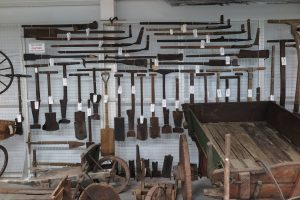 chrom. it is evident that it does not go so straight down into the ground as the garden spade: it penetrates more in a direction sloping forward, ad requires two or three efforts before the soil is turned over; but when turned, there is more ground generally taken up than any other spade, now in use, could accomplish. The reason of its doing more execution is obvious, not only because of the breadth of the iron, but also because the lower part of the handle slopes in a horizontal direction, to receive some of the tough sod to be turned over. The triangular point of the iron qualifies this instrument to enter easily among stones; and the coarseness of the surface, and thinness of the soil, enable it to lay over a greater quantity of sod than any other instrument for digging, which is wrought by the foot. It was in great estimation with the common people, who were won’t to employ it even in fields, when the plough might act; but at present it is seldom used, except onground with a rocky bottom, or on the shelves of rocks, where no plough can be used.
chrom. it is evident that it does not go so straight down into the ground as the garden spade: it penetrates more in a direction sloping forward, ad requires two or three efforts before the soil is turned over; but when turned, there is more ground generally taken up than any other spade, now in use, could accomplish. The reason of its doing more execution is obvious, not only because of the breadth of the iron, but also because the lower part of the handle slopes in a horizontal direction, to receive some of the tough sod to be turned over. The triangular point of the iron qualifies this instrument to enter easily among stones; and the coarseness of the surface, and thinness of the soil, enable it to lay over a greater quantity of sod than any other instrument for digging, which is wrought by the foot. It was in great estimation with the common people, who were won’t to employ it even in fields, when the plough might act; but at present it is seldom used, except onground with a rocky bottom, or on the shelves of rocks, where no plough can be used.
In the islands, the people are said still to use ploughs with one handle; for what reason, it is not easy to conjecture, because two handles give in all cases, more command in the direction of a plough, than one. I was informed that in lea or grass ground, where the case-chrom is to be used in digging the soil, they first of all fix an instrument like a coulter, in a frame of wood resembling a plough-beam, in which a horse is yoked, to cut the tough and matted surface into parallel lines, leaving the intermediate spaces of that breadth which the case-chrom can easily turn up. This kind of plough, if it can be called one, seems to be the only subsidiary to the other instrument.
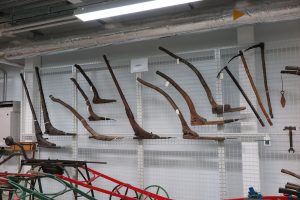 Harrows with wooden teeth, cart-wheels unshod with iron, and without bushes of cast metal to facilitate the motion, tumblers, currants or curates, to carry home corn and hay, baskets for carrying out their dung, another kind of basket for carrying home peats, shades or sledges for particular carriages; and many other instruments of the same rude construction, continue to be used in many districts of this widely extended county. The principal recommendation of these uncouth instruments is, that some of them are well adapted to the state of the roads, or places in that county where there is no road at all; that others of them are cheap to poor people; and that the farmer himself can make and repair them at his own conveniency. At a distance from carpenters and smiths, every man must be frequently at a loss, who has not learned to be handy in these matters. To attempt in this place to describe such rude implements is unnecessary, as there is a hazard that the description might not be understood by those who had never seen them, and that in a few years it would be useless, as it is to be hoped, the objects described will exist no longer.
Harrows with wooden teeth, cart-wheels unshod with iron, and without bushes of cast metal to facilitate the motion, tumblers, currants or curates, to carry home corn and hay, baskets for carrying out their dung, another kind of basket for carrying home peats, shades or sledges for particular carriages; and many other instruments of the same rude construction, continue to be used in many districts of this widely extended county. The principal recommendation of these uncouth instruments is, that some of them are well adapted to the state of the roads, or places in that county where there is no road at all; that others of them are cheap to poor people; and that the farmer himself can make and repair them at his own conveniency. At a distance from carpenters and smiths, every man must be frequently at a loss, who has not learned to be handy in these matters. To attempt in this place to describe such rude implements is unnecessary, as there is a hazard that the description might not be understood by those who had never seen them, and that in a few years it would be useless, as it is to be hoped, the objects described will exist no longer.
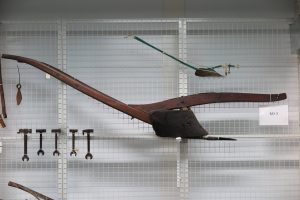 About 35 or 40 years ago, scarcely could a plough or cart-wright be found in all the county, to make the necessary farming utensils in a sufficient manner, or of a proper construction. In these circumstances, every person, who wanted to improve his land, imported loughs, carts, harrows &c of an improved construction from London, or from the port of Leith. But as the demand for machines of a nicer form, and more substantial make, increased, several young men were induced to go from home, and serve apprenticeships with skilful masters; so that properly-bred smiths are carpenters of all denominations are now settled in most of the low and central parts of the county. owing to the want of proper wood and encouragement, and there being no demand in the Islands and Western highlands, skilful artificers have hitherto declined to go thither.
About 35 or 40 years ago, scarcely could a plough or cart-wright be found in all the county, to make the necessary farming utensils in a sufficient manner, or of a proper construction. In these circumstances, every person, who wanted to improve his land, imported loughs, carts, harrows &c of an improved construction from London, or from the port of Leith. But as the demand for machines of a nicer form, and more substantial make, increased, several young men were induced to go from home, and serve apprenticeships with skilful masters; so that properly-bred smiths are carpenters of all denominations are now settled in most of the low and central parts of the county. owing to the want of proper wood and encouragement, and there being no demand in the Islands and Western highlands, skilful artificers have hitherto declined to go thither.
There are ploughs of various constructions, but that generally used is the improved Scottish one, which is made in the county, of every size, and with or without mould-boards of cast iron, according to the opinion of the employer. On gentlemen’s farms we find large harrows for breaking coarse ground, drill-barrows, rollers, banners, thrashing machines, and carts of different constructions, with every other agricultural instrument employed by farmers in any part of Scotland. But very few of the common rank of tenantry, have shown an inclination to adopt the style of dressing their ground in a manner which renders these implements requisite.
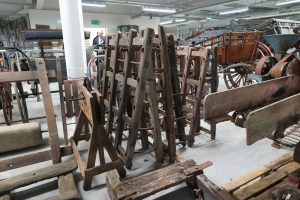 The late Mr Davidson of Canary, was the first to construct a thrashing mill which was driven by horses. He imported all the parts of the machinery from Leith, and brought the tradesman at the same time to join the parts together, and set the machine to work: Mr Forbes of Culloden, Mr Robertson of Inches, Governor Stuart at Fort gorge, Mr Grant at Rothiemurchus, Major fraser of Newton, Mr Anderson, minister at Kingussie, Mr Mitchell at Gordon-hall, and no doubt many other improvers in various parts of the county, have not only thrashing-machines, but many other implements of husbandry, which are used in the
The late Mr Davidson of Canary, was the first to construct a thrashing mill which was driven by horses. He imported all the parts of the machinery from Leith, and brought the tradesman at the same time to join the parts together, and set the machine to work: Mr Forbes of Culloden, Mr Robertson of Inches, Governor Stuart at Fort gorge, Mr Grant at Rothiemurchus, Major fraser of Newton, Mr Anderson, minister at Kingussie, Mr Mitchell at Gordon-hall, and no doubt many other improvers in various parts of the county, have not only thrashing-machines, but many other implements of husbandry, which are used in the 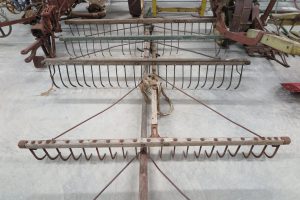 southern counties. Mr Young, formerly mentioned as having several Spanish sheep, showed me a machine in the form of a brake harrow, drawn by one horse, with two handles, for cleaning couch-grass and other fibrous weeds from ploughed land. Its execution is very great, not only in cleaning and pulverising the soil, where the ground is level, and free of obstructions. Machines area also made in the eastern districts of the county, for bruising the succulent tops of furze to make provender for horses, ins reasons when the crop of grain is hot, and straw and hay scanty. The year old shoots of this plant afford a convenient substitute at a small expense, which is at the same time rich and wholesome food. The common class of farmers, who have no machines for that purpose, heat these tops of furze with the flail; by which means their horses, it is said, with very little other subsistence, are enabled to carry on the labours of the spring.
southern counties. Mr Young, formerly mentioned as having several Spanish sheep, showed me a machine in the form of a brake harrow, drawn by one horse, with two handles, for cleaning couch-grass and other fibrous weeds from ploughed land. Its execution is very great, not only in cleaning and pulverising the soil, where the ground is level, and free of obstructions. Machines area also made in the eastern districts of the county, for bruising the succulent tops of furze to make provender for horses, ins reasons when the crop of grain is hot, and straw and hay scanty. The year old shoots of this plant afford a convenient substitute at a small expense, which is at the same time rich and wholesome food. The common class of farmers, who have no machines for that purpose, heat these tops of furze with the flail; by which means their horses, it is said, with very little other subsistence, are enabled to carry on the labours of the spring.
The photographs of the “traditional” implements were taken at the Highland Folk Museum, Newtonmore.
